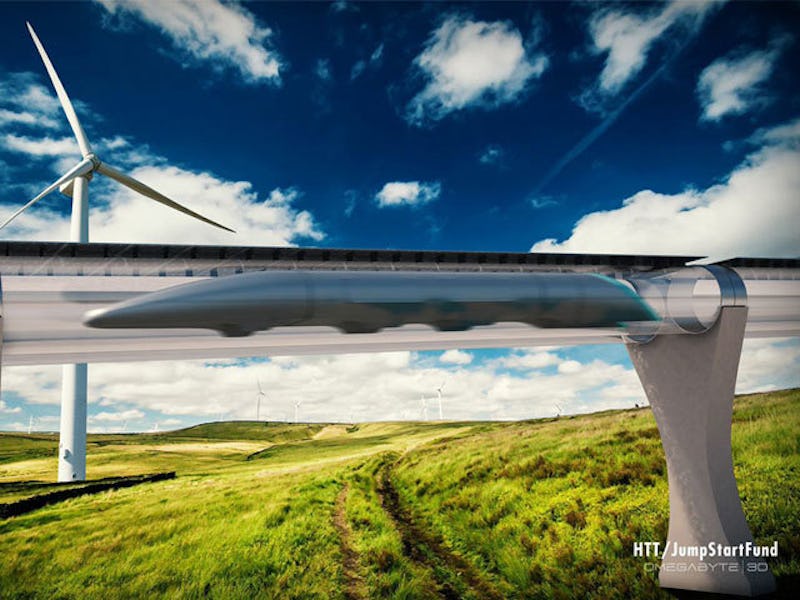Hyperloop: How It Could Join With Electric Planes and Cars in Just 5 Years
The transit system of the future may be just around the corner.

Hyperloop could start to form an interconnected mesh of electric cars and flying machines in just five years’ time, with the famously difficult-to-achieve vacuum-sealed tube whizzing pods across flat landscapes to provide an alternative to the jet engine.
The transit system, first detailed by Elon Musk in a 2013 white paper, could traverse the 380 miles between San Francisco and Los Angeles in just 35 minutes at a speed of 760 mph. It’s come under criticism from experts that question, among other issues, whether a sealed tube would work — as in, stay sealed — work over such long distances.
Not only would it work, one industry expert claims, but a track could emerge within a decade.
Thierry Marin-Martinod, aerospace and defense chief technology officer for Switzerland-based TE Connectivity, tells Inverse that “we should see a project” in “best case, five, less than eight years.” (TE Connectivity is a sponsor of rLoop, a Reddit-formed team that competed in SpaceX’s first hyperloop competition in January 2017.)
This hyperloop project, Marin-Martinod explains, will probably emerge where it makes most geographic sense. Building a tube along a flat, empty land is easier than snaking around or through mountains and hills. A plane can cruise at nearly 600 mph, and many of its routes will continue simply because a hyperloop could not traverse those same terrains. The same applies to cars that only need a road, and trains that don’t require any vacuum-sealed tubes.
So if planes and airports are everywhere and offer similar speeds, why build a hyperloop? It could offer a more eco-friendly solution. Musk’s original white paper described placing solar panels along the tube to generate more than enough electricity, and Virgin Hyperloop One has been exploring how to build clean energy into its designs.
Marin-Martinod does not expect full-size electric jets for another 20 years, with smaller single-passenger designs taking to the skies in the next few years. Hyperloop could bridge the gap before that point.
Hyperloop station concept design by Delft Hyperloop.
Another area where hyperloop could win is on multi-modal transport. Planes require the passenger to queue for hours in security, taking their shoes off and sometimes going through a body scanner. Instead of the hours taken at either end, hyperloop could connect with and enable seamless switching between other modes of transport. It’s akin to how the Channel Tunnel between the United Kingdom and France loads cars onto a giant train, then moves that train through the tunnel. Audi and Airbus have designed a pod capable of linking to ground, air, and hyperloop forms of transport without the passenger ever leaving the pod.
Where could the first track go? The biggest decider could be money. Marin-Martinod suggests China and countries in the Middle East could have the finances to support an initial track.
“There are some areas which are very, very ideal,” Marin-Martinod says. “The Middle East, in the desert, you have sand, you want to go from point A to B very fast. That’s a perfect solution. So I strongly believe we will see some Hyperloop project, yes, because it makes sense.”
The hyperloop could also crop up elsewhere. Richard Branson-backed Virgin Hyperloop One is currently completing a feasibility study into an India track between Mumbai and Pune. The route, which cuts a three-hour train journey to 25 minutes, has been described by the firm as “the strongest economic case that we have seen to-date.” The firm is building a feasibility study for a first phase demonstration track.
Mumbai to Pune.
The firm is also looking at a feasibility study for Missouri.
Beyond Virgin Hyperloop One, SpaceX has held four student-focused competitions to design the fastest hyperloop pod at its California campus. TUM Hyperloop achieved 288 mph in the most recent July competition, coming to an abrupt stop over a 0.8-mile track. SpaceX plans to lengthen the track to 6.2 miles for the next event. Delft Hyperloop previously told Inverse that hyperloop could achieve its maximum speeds over 44 miles, giving enough distance to smoothly brake and accelerate.
It’s unclear where the first public track will emerge or how it will look, but hyperloop’s success may come down to where it makes the most sense versus other forms of transport. Similar to how renewable energy is a multi-pronged fight, hyperloop could form part of a broader collection of eco-friendly modes of transport. Countries are installing wind, solar, hydro and other means of generating electricity, choosing the one that best fits the situation. Hyperloop could play a similar role.
“You can replace a nuclear power plant with 10 different solutions,” Marin-Martinod says. “And that’s the way we have to see the future of these electrical vehicles.”